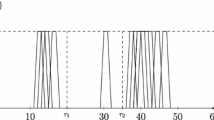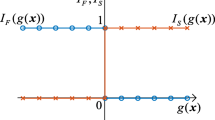Abstract
Reliability analysis comprises statistical analysis techniques that make inferences based on life time data. Swift progress has been observed in life time data analyses during the last few decades. Accelerated life testing models are regarded as the most popular techniques for engineering life time data analysis. Their main aim is to model life times under different stress levels that are more severe than the usual stress level. The existing techniques consider life times as precise measurements and do not contemplate the imprecision of observations. In fact, life time measurements are not precise quantities but more or less fuzzy. Therefore, in addition to standard statistical tools, fuzzy model approaches are also essential. The current study generalizes some parametric and nonparametric classical estimation procedures for accelerated life testing in order to accommodate both fuzziness and random variation. The proposed estimators cover both uncertainties, which make them more applicable and practicable for life time analysis. The results of fuzzy life times are considered under various stress conditions, and comparisons with precise life time analysis are further presented in examples.














Similar content being viewed by others
Explore related subjects
Discover the latest articles, news and stories from top researchers in related subjects.References
Balakrishnan N, Kundu D, Ng HKT, Kannan N (2007) Point and interval estimation for a simple step-stress model with type II censoring. J Qual Technol 39(1):35–47
Barbato G, Germak A, Genta G, Barbato A (2013) Measurements for decision making. Measurements and basic statistics. Esculapio, Milano
Frühwirth-Schnatter S (1993) On fuzzy Bayesian inference. Fuzzy Sets Syst 60(1):41–58
Gil MÁ, Hryniewicz O (2009) Statistics with imprecise data. In: Meyers RA (ed) Encyclopedia of complexity and systems science. Springer, New York, pp 8679–8690
Gonzalez-Gonzalez DS, Alejo RJP, Cantú-Sifuentes M, Torres-Treviño LM, Méndez GM (2014) A non-linear fuzzy regression for estimating reliability in a degradation process. Appl Soft Comput 16:137–147
Huang H-Z, Zuo MJ, Sun Z-Q (2006) Bayesian reliability analysis for fuzzy lifetime data. Fuzzy Sets Syst 157(12):1674–1686
Hung W-L, Liu Y-C (2004) Estimation of Weibull parameters using a fuzzy least-squares method. Int J Uncertain Fuzziness Knowl Based Syst 12(5):701–711
Klir GJ, Yuan B (1995) Fuzzy sets and fuzzy logic: theory and applications. Prentice-Hall, New Jersey
Lee E, Wang J (2013) Statistical methods for survival data analysis. Wiley, New Jersey
Liu L, Li X-Y, Zhang W, Jiang T-M (2015) Fuzzy reliability prediction of rotating machinery product with accelerated testing data. J Vibroeng 17(8):4193–4210
Nelson W (2009) Accelerated testing: statistical models, test plans, and data analysis. Wiley, New Jersey
Pak A, Parham G, Saraj M (2013) Reliability estimation in Rayleigh distribution based on fuzzy lifetime data. Int J Syst Assur Eng Manag 5(4):487–494
Shafiq M, Atif M (2015) On the survival models for step-stress experiments based on fuzzy life time data. Qual Quant 51(1):79–91
Shafiq M, Viertl R (2015a) Empirical reliability functions based on fuzzy life time data. J Intell Fuzzy Syst 28(2):707–711
Shafiq M, Viertl R (2015b) Generalized Kaplan Meier estimator for fuzzy survival times. Sil Stat Rev 13(19):7–14
Shafiq M, Khalil A, Atif M, Zaman Q (2016) Empirical acceleration functions and fuzzy information. Int J Uncertain Quant 6(3):215–228
Shaked M, Zimmer WJ, Ball CA (1979) A nonparametric approach to accelerated life testing. J Am Stat Assoc 74(367):694–699
Shapiro AF (2013) Modeling future lifetime as a fuzzy random variable. Insur: Math Econ 53(3):864–870
Viertl R (1988) Statistical methods in accelerated life testing. Vandenhoeck & Ruprecht, Göttingen
Viertl R (2004) Accelerated life testing, fuzzy information and generalized probability. In: Balakrishnan N, Nikulin M, Mesbah M, Limnios N (eds) Parametric and semiparametric models with applications to reliability, survival analysis, and quality of life, statistics for industry and technology. Birkhäuser, Boston, pp 99–105
Viertl R (2011) Statistical methods for fuzzy data. Wiley, Chichester
Viertl R, Gurker W (1995) Reliability estimation based on fuzzy life time data. In: Onisawa T, Kacprzyk J (eds) Reliability and safety analyses under fuzziness. Springer, Berlin, pp 153–168
Viertl R, Hareter D (2006) Beschreibung und analyse unscharfer information: statistische methoden für unscharfe daten. Springer, Wien
Wu H-C (2004) Fuzzy Bayesian estimation on lifetime data. Comput Stat 19(4):613–633
Xu H, Li X, Liu L (2015) Statistical analysis of accelerated life testing under Weibull distribution based on fuzzy theory. In: 2015 annual reliability and maintainability symposium (RAMS), IEEE, Palm Harbor, FL, pp 1–5
Zadeh L (1965) Fuzzy sets. Inf Control 8(3):338–353
Author information
Authors and Affiliations
Corresponding author
Ethics declarations
Conflict of interest
In this paper, the authors have no conflict of interest.
Human and animal rights
Furthermore, this study does not have any involvement with human-related data and only used computer-simulated data.
Additional information
Communicated by A. Genovese and G. Bruno.
Rights and permissions
About this article
Cite this article
Shafiq, M., Atif, M. & Viertl, R. Beyond precision: accelerated life testing for fuzzy life time data. Soft Comput 22, 7355–7365 (2018). https://doi.org/10.1007/s00500-018-3067-3
Published:
Issue Date:
DOI: https://doi.org/10.1007/s00500-018-3067-3




